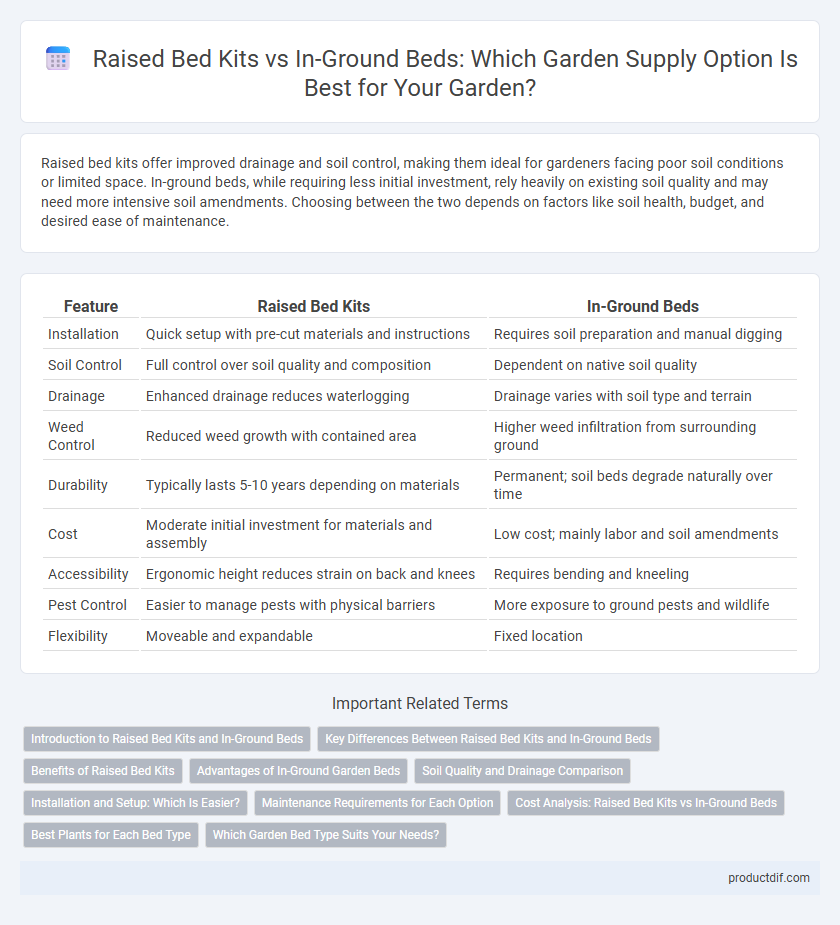Raised bed kits offer improved drainage and soil control, making them ideal for gardeners facing poor soil conditions or limited space. In-ground beds, while requiring less initial investment, rely heavily on existing soil quality and may need more intensive soil amendments. Choosing between the two depends on factors like soil health, budget, and desired ease of maintenance.
Table of Comparison
| Feature | Raised Bed Kits | In-Ground Beds |
|---|---|---|
| Installation | Quick setup with pre-cut materials and instructions | Requires soil preparation and manual digging |
| Soil Control | Full control over soil quality and composition | Dependent on native soil quality |
| Drainage | Enhanced drainage reduces waterlogging | Drainage varies with soil type and terrain |
| Weed Control | Reduced weed growth with contained area | Higher weed infiltration from surrounding ground |
| Durability | Typically lasts 5-10 years depending on materials | Permanent; soil beds degrade naturally over time |
| Cost | Moderate initial investment for materials and assembly | Low cost; mainly labor and soil amendments |
| Accessibility | Ergonomic height reduces strain on back and knees | Requires bending and kneeling |
| Pest Control | Easier to manage pests with physical barriers | More exposure to ground pests and wildlife |
| Flexibility | Moveable and expandable | Fixed location |
Introduction to Raised Bed Kits and In-Ground Beds
Raised bed kits provide a controlled gardening environment with improved soil drainage and reduced weed growth, ideal for urban gardens or areas with poor soil quality. In-ground beds utilize the existing soil, offering deeper root penetration and natural ecosystem benefits, often preferred for large-scale or traditional gardening. Choosing between raised bed kits and in-ground beds depends on soil conditions, space availability, and specific crop requirements.
Key Differences Between Raised Bed Kits and In-Ground Beds
Raised bed kits offer enhanced soil control, improved drainage, and reduced weed growth compared to in-ground beds, making them ideal for gardeners with poor or compacted soil. In-ground beds rely on existing soil conditions, which can limit plant growth and increase the need for soil amendments and weed management. Maintenance requirements differ, as raised beds often require less effort to manage soil quality and pests, while in-ground beds demand ongoing soil improvement and weed control.
Benefits of Raised Bed Kits
Raised bed kits improve soil drainage and prevent compaction, promoting healthier root growth and higher crop yields. These kits allow for precise soil control and easier weed management, reducing maintenance efforts compared to in-ground beds. Elevated structures also extend the growing season by warming up faster in spring, perfect for diverse garden plants.
Advantages of In-Ground Garden Beds
In-ground garden beds offer superior root expansion and natural soil ecosystem interactions, which enhance nutrient availability and water retention. They are cost-effective, requiring minimal setup compared to raised bed kits, and naturally regulate soil temperature through seasonal changes. This method supports a wider range of plant species, benefiting from existing soil microbiota and earthworm activity for healthier crop growth.
Soil Quality and Drainage Comparison
Raised bed kits offer superior soil quality control by allowing gardeners to fill beds with optimal, nutrient-rich soil tailored to plant needs, unlike in-ground beds that depend on existing soil conditions which may be compacted or nutrient-deficient. Drainage is significantly improved in raised beds due to elevated soil levels promoting faster water runoff, reducing the risk of waterlogging common in poorly draining in-ground beds. This controlled environment in raised beds supports healthier root development and reduces soil erosion compared to traditional in-ground planting methods.
Installation and Setup: Which Is Easier?
Raised bed kits offer a streamlined installation process with pre-cut materials and clear instructions, making setup quick and accessible for gardeners of all skill levels. In-ground beds require more effort to prepare the soil, including removing grass, tilling, and amending, which can be labor-intensive and time-consuming. Overall, raised bed kits provide a more user-friendly and efficient setup experience compared to traditional in-ground beds.
Maintenance Requirements for Each Option
Raised bed kits require less weeding and better soil drainage, reducing maintenance efforts compared to in-ground beds. In-ground beds often demand more frequent soil amendment and pest control to maintain plant health. Proper planning for irrigation is crucial in both options, but raised beds generally offer easier moisture management and accessibility.
Cost Analysis: Raised Bed Kits vs In-Ground Beds
Raised bed kits typically involve higher upfront costs due to pre-cut materials and assembly components, averaging $150 to $400 per kit, while in-ground beds primarily require soil and basic tools, costing significantly less initially. Long-term maintenance expenses for raised beds may increase with material replacement but can reduce soil amendments and weed control costs compared to in-ground beds. Evaluating both options based on durability, soil quality improvement, and labor investment offers a comprehensive cost analysis for garden supply decisions.
Best Plants for Each Bed Type
Raised bed kits offer superior drainage and soil control, making them ideal for growing root vegetables like carrots, beets, and onions that require loose, well-aerated soil. In-ground beds benefit plants with extensive root systems such as tomato, squash, and corn, which thrive in the natural soil structure and depth. Choosing the best plants depends on soil quality, moisture retention, and root depth preferences specific to raised or in-ground garden beds.
Which Garden Bed Type Suits Your Needs?
Raised bed kits offer improved soil drainage, pest control, and ease of access, making them ideal for gardeners with limited space or poor soil conditions. In-ground beds provide a larger planting area and better integration with existing soil ecosystems, suitable for experienced gardeners seeking natural soil fertility. Choosing the right garden bed type depends on factors like soil quality, available space, budget, and physical accessibility requirements.
Raised bed kits vs In-ground beds Infographic

 productdif.com
productdif.com